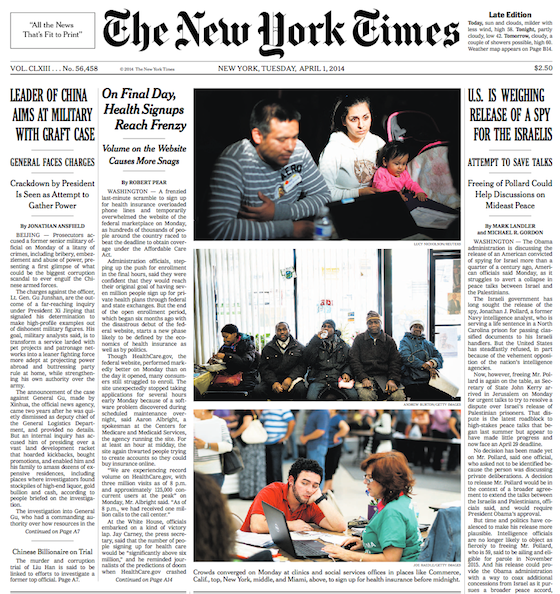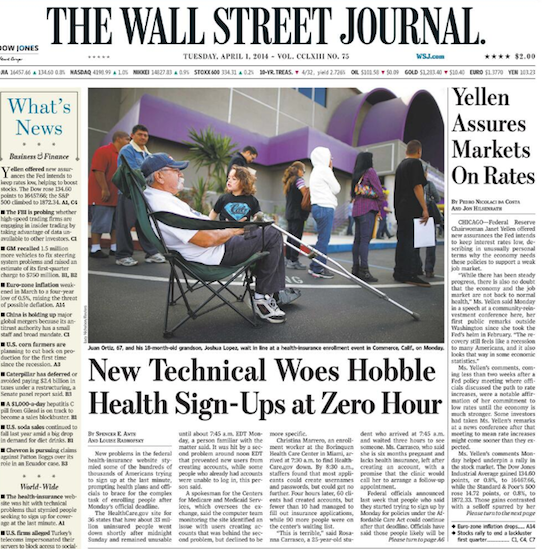Contrast how The New York Times and The Wall Street Journal frame the Obamacare news on their front pages:
The Times gets it just right:
Health Care Signups Reach Frenzy in Final Day to Enroll
Volume on the Website Causes More Snags
The Journal, though, slants its headline to focus entirely on the bugs the website had yesterday:
New Technical Woes Hobble Health-Insurance Sign-Ups at Zero Hour
It doesn’t mention—even in the body of the story—were due to the enormous last-minute demand for health-care plans. The fact that hundreds of thousands of people pushed Obamacare over the 7 million goal is a far bigger story than the website crashing for a while.
The Washington Post, meanwhile, fronted this headline, which works fine:
HealthCare.gov hiccups amid deadline-day frenzy
Americans racing to sign up before midnight encounter glitches
See James Fallows for more on the slant that shows up too often in the Murdoch-era Journal.
— Check out this great site from NYU on undercover reporting and its role in the great stories of the last 150 years.
This collaboration with NYU Libraries collects many decades of high-impact, sometimes controversial, mostly U.S.-generated journalism that used undercover techniques. It grows out of the research for Undercover Reporting: The Truth About Deception (Northwestern University Press, 2012), which argues that much of the valuable journalism since before the U.S. Civil War has emerged from investigations that employed subterfuge to expose wrong. It asserts that undercover work, though sometimes criticized as deceptive or unethical, embodies a central tenet of good reporting–to extract significant information or expose hard-to-penetrate institutions or social situations that deserve the public’s attention. The site, designed as a resource for scholars, student researchers and journalists, collects some of the best investigative work going back almost two centuries.
Look at the “Other People’s Work” section, which highlights dozens of undercover reports ranging from the mattress factories of Minnesota in 1888 to a Toronto Star report from last year on child labor in Bangladesh. Fascinating.
— This Fortune piece on “Why America’s fear of ‘too big to fail’ is irrational” is a bit off (emphasis mine):
The U.S. Federal Reserve recently concluded that six of America’s biggest banks enjoy about $8.5 billion a year in savings, mostly in the form of paying lower borrowing costs than smaller institutions. That might sound unfair, but that’s a pretty small price U.S. taxpayers effectively pay to avoid another financial crisis. In addition, the Troubled Asset Relief Program, though unpopular, actually netted a profit for taxpayers as the government’s investments have been gradually wound down; and then there is the case of Ally, the former General Motors finance subsidiary, whose planned IPO will result in a gain for the public.
Still, the fear of “too big to fail” persists. The reason for this is a lack of understanding of why our biggest banks can’t really be allowed to fail.
“Too big to fail” doesn’t exist because we have sympathy for Citigroup or JPMorgan Chase or because Wall Street is too powerful. It exists to preserve the integrity of the global financial system, which is a complex and interconnected web of financial relationships that cannot realistically be insulated from the downfall of even a single large bank.
Fortune is saying that these TBTF subsidies are what Americans pay to avoid financial crises. That’s just staggeringly wrong. Those subsidies (which most studies conclude are far larger than $8.5 billion a year) are what banks get because markets perceive them as too big to fail and thus lend to them at lower rates.
But big banks got these indirect subsidies for years years before the 2008 crisis too. An implicit government backstop doesn’t prevent a financial crisis from occurring. If anything, it makes it more likely.
Ryan Chittum is a former Wall Street Journal reporter, and deputy editor of The Audit, CJR’s business section. If you see notable business journalism, give him a heads-up at rc2538@columbia.edu. Follow him on Twitter at @ryanchittum.


